Cleaning concrete surfaces, whether a driveway, patio, or flooring, can be challenging, especially when dealing with stubborn stains like grease, oil, or rust.
While various cleaning methods are available, using muriatic acid is one of the most effective solutions for tackling tough stains and restoring the appearance of concrete.
Fortunately, muriatic acid, also known as hydrochloric acid, can be an effective solution for restoring the pristine appearance of concrete. However, it’s crucial to approach this process cautiously and follow proper safety protocols. Let’s walk you through how to clean concrete with muriatic acid step by step.
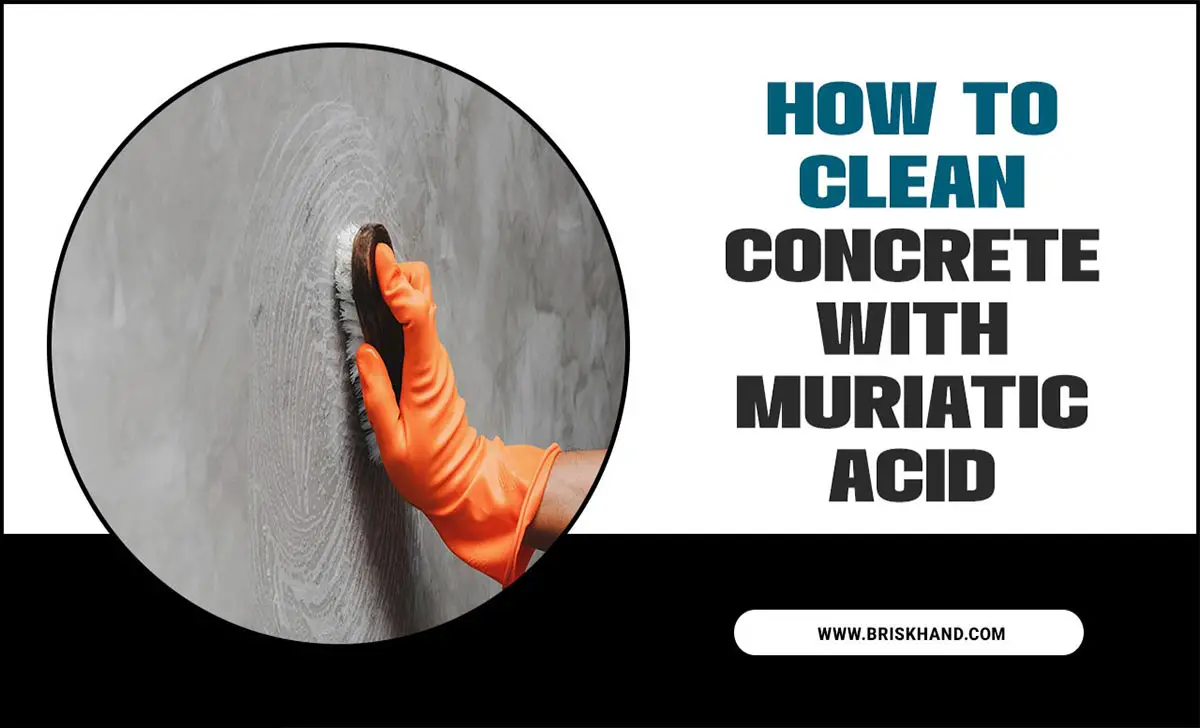
Frustrated By Unsightly Stains On Your Concrete Driveway Or Garage Floor?
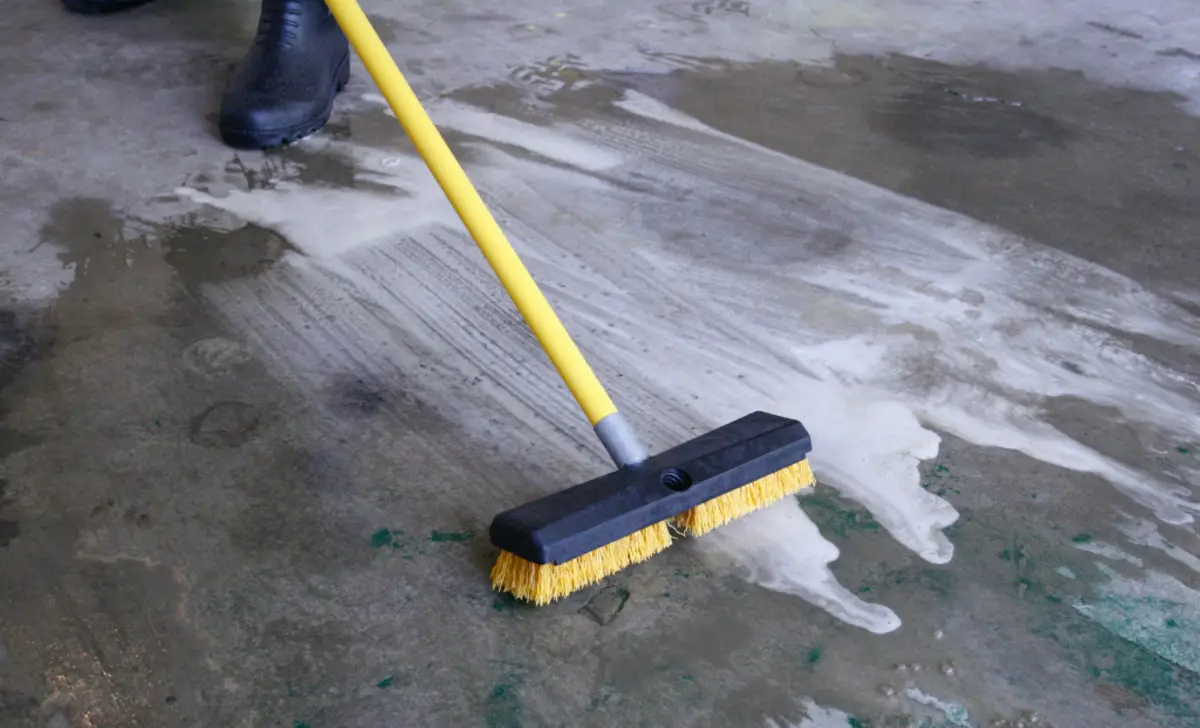
Is your driveway or garage floor stained with oil, paint, dirt, or mildew? This is where acid washing may be handy. Cleaning concrete this way effectively manages stubborn stains, discoloration, or dirt buildup that you can’t remove with conventional cleaning methods.
However, muriatic acid is typically reserved for specific scenarios where conventional cleaning methods have proven ineffective. Here are some valid purposes for using muriatic acid to clean concrete:
- Handling tough stains from oil, grease, rust, mineral deposits, and efflorescence from concrete surfaces.
- Restoring appearance
- Preparation for surface treatments
- For hygiene and sanitation in commercial kitchens, food processing facilities, or healthcare facilities.
- Cost-effective compared to other cleaning methods or professional cleaning services.
Use In Limit: Muriatic Acid Can Ruin Concrete

Muriatic acid, or hydrochloric acid, is a powerful chemical compound commonly used for cleaning and etching concrete surfaces. It is highly acidic, so you must handle it carefully due to its corrosive nature.
The corrosive nature of muriatic acid means that it can dissolve the top layer of concrete, leading to etching, discoloration, or even structural damage if used in excessive concentrations or left on the surface for too long.
Factors that can cause potential damage to concrete by muriatic acid are high concentration ratio & extended exposure time:
- Mix 1 part muriatic acid with 10 parts water for general concrete cleaning and maintenance.
- Increase the concentration for tougher stains or heavily soiled areas by mixing 1 part muriatic acid with 5-8 parts water.
- Exposure times should typically range from 5 to 15 minutes, depending on the acid solution concentration and the severity of the stains.
Here Is The Best Way To Clean Concrete With Muriatic Acid

Before beginning the cleaning process, assess the condition of the concrete surface. Identify any specific stains or areas that require attention. Diluting the acid, minimizing exposure time, and taking appropriate safety precautions are essential to prevent muriatic acid from ruining concrete.
If unsure about using muriatic acid, consider alternative cleaning methods or consult a professional for advice. Scroll down, and here are the 5 easy steps to perform. But first, gather the necessaries.
Materials Needed:
- Muriatic acid
- Water
- Plastic Bucket
- Stiff-bristled brush (scrub brush, stiff brush) or scrubbing pad
- Garden hose or pressure washer
- Protective gear (safety goggles, rubber gloves, long sleeves, rubber boots)
- Neutralizing agent (baking soda or ammonia solution)
Step -1 (Dilute the Muriatic Acid):
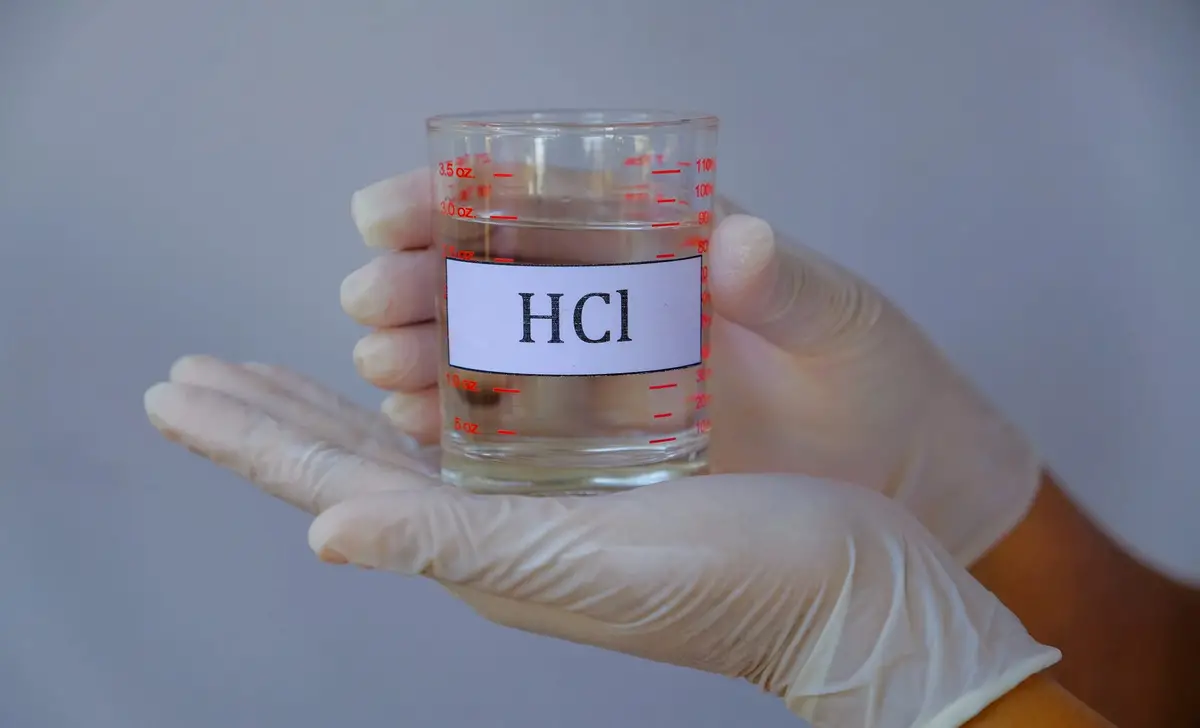
Select a non-metallic container large enough to hold the desired diluted acid solution. Always start with a lower concentration of acid and adjust as necessary. Testing the solution on a small, inconspicuous area of the concrete surface is crucial before applying it more broadly.
The recommended dilution ratio is typically one part acid to ten parts water, but this may vary depending on the stains’ severity and the concrete type. Always add acid to water, never the other way around, to avoid splashes and reactions.
Step -2 (Pre-wet the Surface to Prepare the Area):

Before applying the muriatic acid solution, pre-wet the concrete surface with clean water. This helps to prevent the acid from penetrating too deeply into the concrete and causing damage. Clear the concrete surface of any debris, furniture, or obstacles. Sweep the area thoroughly to remove loose dirt and grime.
Step -3 (Apply the Acid Solution & Scrub the Surface):
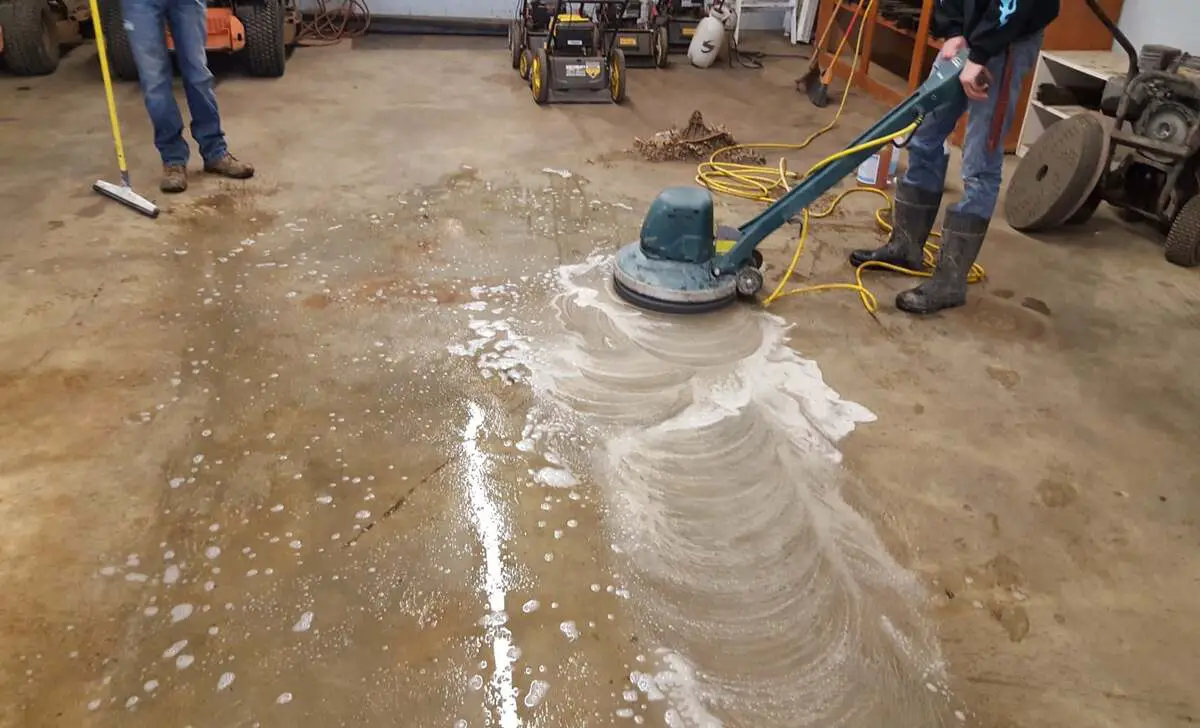
Apply the diluted muriatic acid solution evenly onto the concrete surface using a plastic watering can or sprayer. Be cautious not to oversaturate the area, as excessive acid can damage the concrete.
Allow the acid solution to sit on the concrete for a few minutes to penetrate and loosen the stains. Then, using a stiff-bristled brush or scrubbing pad, scrub the surface vigorously to agitate the stains and dirt. Focus on areas with stubborn stains or discoloration.
Step -4 (Rinse & Neutralize the Acid):
Once the surface has been thoroughly scrubbed, rinse it with clean water using a garden hose or pressure washer. Ensure all traces of the acid solution are completely removed from the concrete surface.
After rinsing, neutralize any remaining acid residue on the concrete by applying a solution of baking soda or ammonia mixed with water.
To neutralize the acid, you can mix one cup of either baking soda, garden lime, or household ammonia in one gallon of water (approximately 250 mL in 4 L). This solution will help balance the acid levels effectively. This will help counteract the acidity and prevent further damage to the concrete.
Step -5 (Final Rinse, then Apply a Concrete Sealer):
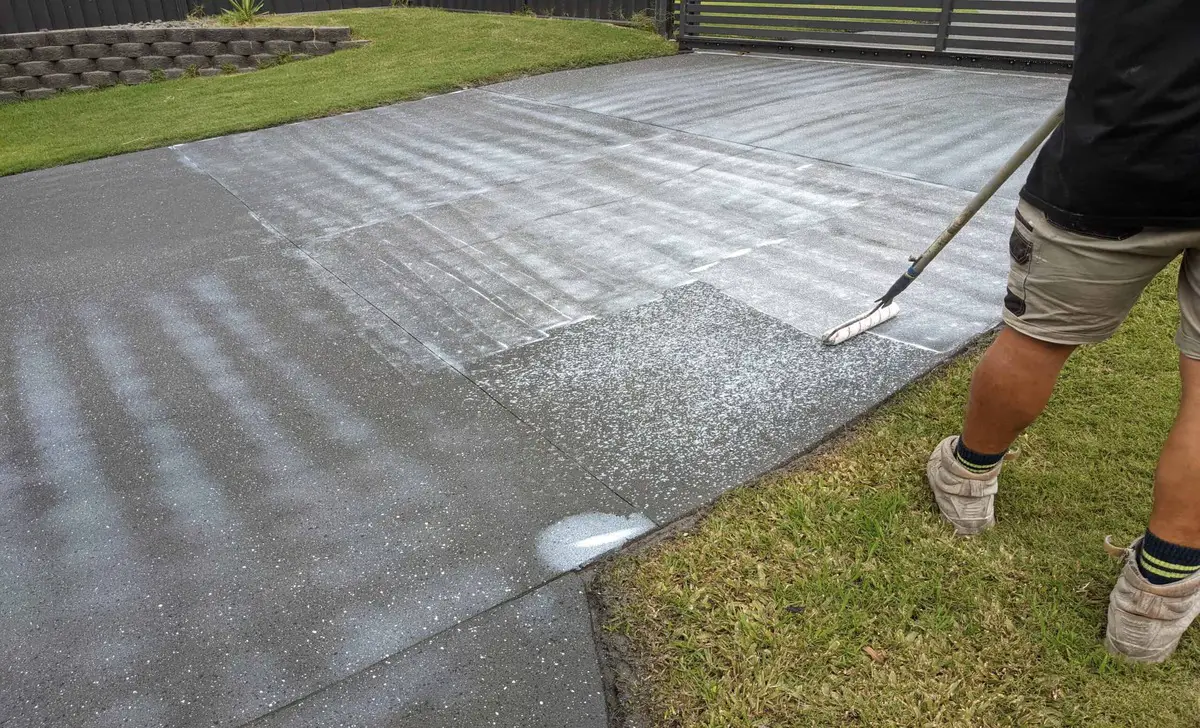
Give the concrete surface a final rinse with clean water to remove any residual neutralizing agent and ensure a thorough clean. After the surface has dried, inspect it for any remaining stains or areas requiring additional cleaning.
If necessary, repeat the process of applying muriatic acid and scrubbing until the desired results are achieved. Consider applying a concrete sealer to protect the surface from future stains and damage.
Acid Wash (Concrete) Mix Ratio
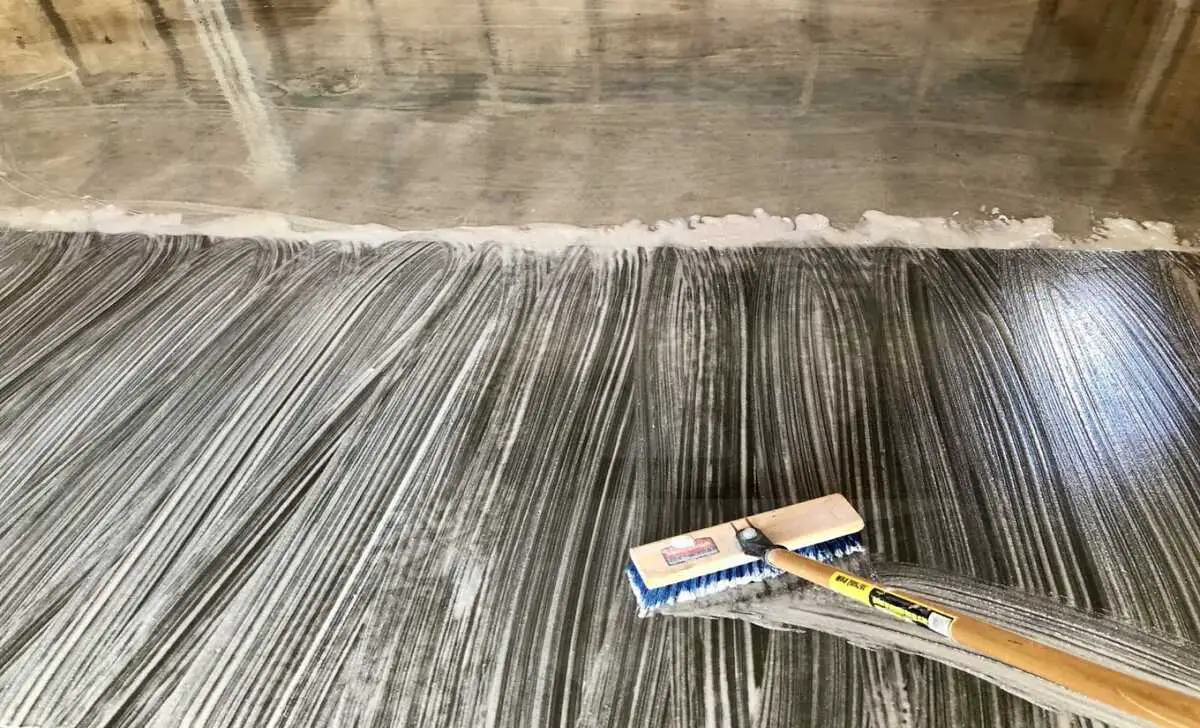
When diluting muriatic acid for cleaning concrete, adjust the proportion of acid to water according to the area of the treated concrete surface. This ensures effective cleaning without causing damage to the concrete. Here’s how you can expand the proportion to mix based on the area of concrete:
1.Small Area (Less than 100 Square Feet):
- A relatively low concentration of muriatic acid is sufficient for small concrete areas, such as a patio or walkway.
- Mix 1 part muriatic acid with 10 parts water.
2.Medium Area (100 – 500 Square Feet):
- For medium-sized concrete surfaces, like a driveway or garage floor, a slightly higher concentration may be needed to tackle tougher stains.
- Mix 1 part muriatic acid with 8 parts water.
3.Large Area (Over 500 Square Feet):
- When dealing with large areas of concrete, such as a warehouse floor or commercial space, a stronger solution may be required for effective cleaning.
- Mix 1 part muriatic acid with 6 parts water.
4.Heavy Stains or Stubborn Areas:
- In cases with heavy stains or particularly stubborn areas of dirt or grime, you may need to increase the concentration of muriatic acid.
- Mix 1 part muriatic acid with 5 parts water for targeted spot cleaning or stain removal.
Safety Precautions:
Don’t forget to consider using a concrete cleaner like Simple Green or a cleaning solution specifically designed for concrete floors to maintain their pristine condition. You may try techniques and products in your cleaning routine, and you can keep your concrete driveway, concrete flooring, or concrete pavers looking fresh and well-maintained for longer periods.
Remember to prioritise safety and follow proper guidelines when using muriatic acid or other cleaning agents to achieve the best results without causing any harm to yourself or the concrete surfaces.
- Always wear appropriate protective gear when handling muriatic acid, including gloves, goggles, and a mask.
- Work in a well-ventilated area to minimize exposure to fumes.
- Keep children and pets away from the cleaning area.
- Properly dispose of any leftover muriatic acid and rinse all equipment thoroughly after use.
What Not To Do With Muriatic Acid
Avoid using it on clean concrete floors, as it can cause damage. Never mix muriatic acid with other chemicals, especially household cleaners or products containing ammonia. Mixing cleaning acid with certain substances can produce toxic fumes or hazardous reactions that pose serious health risks.
- Do Not Mix with Other Chemicals:
- Do Not Use Undiluted
- Do Not Apply to Wet Surfaces
- Do Not Overexpose
- Do Not Dispose Improperly
- Do Not Neglect Safety Gear
- Do Not Store Improperly
Here Are Some Tips For Success:
Test the muriatic acid solution on a small, inconspicuous area of the concrete surface before applying it to the entire area to ensure compatibility and avoid damage. Work in small sections to prevent the acid solution from drying out before you can scrub and rinse it thoroughly.
Avoid prolonged exposure of the acid solution to the concrete, as this can cause etching and damage the surface. Dispose of leftover muriatic acid and neutralizing agents properly according to local regulations.
What To Do If Stains Remain?
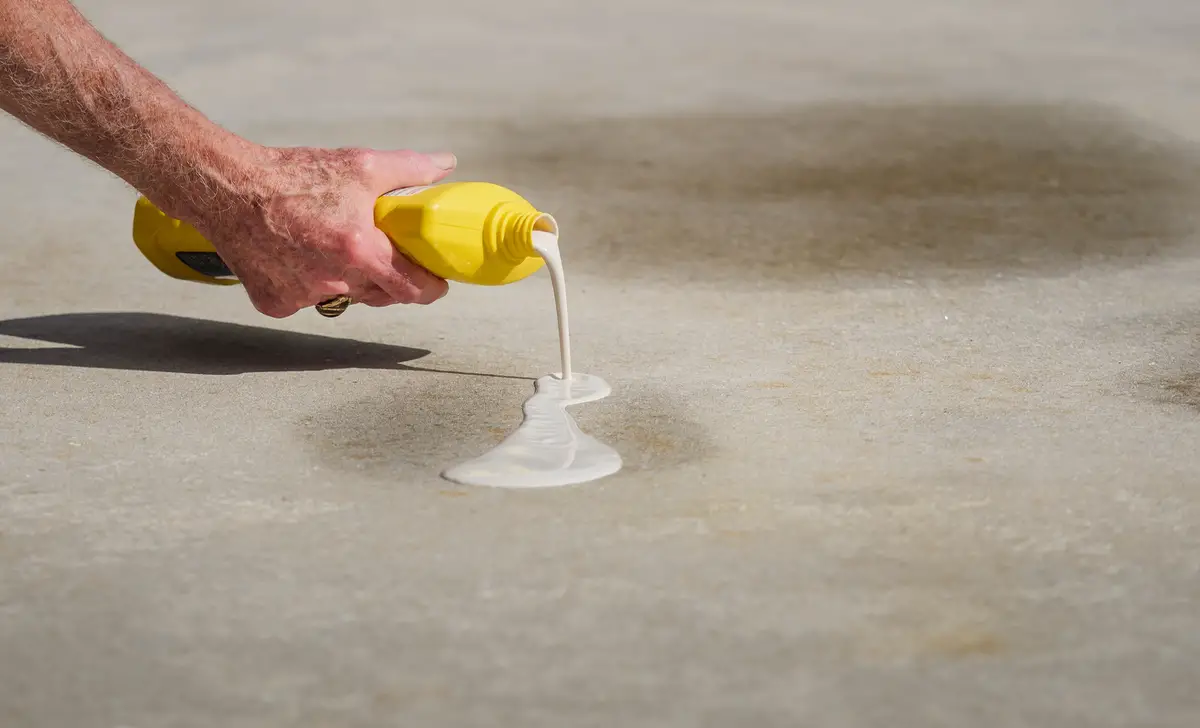
- Repeat the cleaning process and adjust the concentration of the cleaning solution or the duration of exposure as necessary.
- Consider spot-treating the affected areas with a more concentrated solution.
- Consider mechanical agitation
- Or use alternative cleaning agents. For example, grease stains may respond better to degreasers or specialized concrete cleaners.
If stains remain on concrete surfaces, various strategies can be employed to address the issue. One option is to use muriatic acid to remove tough stains and blemishes effectively. Additionally, decorative concrete techniques such as acid wash or concrete stain can be applied to enhance the appearance of the surface.
For a more durable solution, epoxy floor coatings can protect and revitalize stained concrete floors. In cases where masonry surfaces are affected by stains, professional roof cleaning services may be necessary to restore their original condition. So, consult a professional if the stains are particularly stubborn or if you are unsure about the appropriate course of action.
Conclusion:
Cleaning concrete with muriatic acid can effectively remove tough stains and revitalise the appearance of concrete surfaces. However, it’s essential to approach this task cautiously and follow proper safety procedures to prevent accidents and damage to the concrete.
In addition to muriatic acid, other methods such as pressure washing, using vinegar, or soft washing can also be effective in removing stains like oil stains, rust stains, and grease stains from concrete surfaces.
For more intricate designs and surfaces like concrete countertops or indoor concrete, decorative techniques such as acid washing or applying acrylic sealers can enhance the overall look.
FAQs
1.What Is The Best Way To Neutralize Muriatic Acid?
The best way to neutralize muriatic acid is by using a solution of baking soda or ammonia mixed with water. Apply the neutralizing solution to the affected area and rinse thoroughly with clean water.
2.How Often Should Muriatic Acid Be Used To Clean Concrete?
You should use such acid to clean concrete only as needed, typically on an infrequent basis. Overuse can damage the concrete surface, and you should avoid it. Follow manufacturer recommendations for safe usage.
3.How Does Muriatic Acid Affect The Color Of Concrete?
Muriatic acid can lighten or darken the color of concrete, depending on factors such as concentration, exposure time, and the composition of the concrete. Test in a small area before full application.
4.How Do You Clean A Mortar With Muriatic Acid?
To clean mortar with muriatic acid, dilute it with water, apply to the mortar joints using a brush, scrub thoroughly, and rinse with water. Exercise caution to prevent damage to surrounding surfaces.
5.How Do You Clean A Pool Filter Cartridge With Muriatic Acid?
Soak the pool filter cartridge in a solution of diluted muriatic acid and water, scrubbing gently to remove buildup. Rinse thoroughly with clean water before reinstalling.
6.What Are The Effects Of Muriatic Acid On Concrete Exposed To High Temperatures?
High temperatures can accelerate the corrosive effects of muriatic acid on concrete, leading to increased etching, discoloration, or structural damage. Use with caution and monitor closely.
7.Will Muriatic Acid Remove Concrete From Brick?
Muriatic acid can dissolve concrete from brick surfaces, but it may also damage the brick. Test in a small, inconspicuous area first and proceed with caution.
8.What Is A Substitute For Muriatic Acid In Concrete?
Vinegar or citric acid can be used as substitutes for muriatic acid in concrete cleaning. These alternatives are less harsh but may require longer exposure or more scrubbing.
9.What Do Professionals Use To Clean Concrete?
Professionals may use specialized equipment such as pressure washers, steam cleaners, or chemical cleaners tailored to the specific needs of the concrete surface. They follow safety protocols and ensure thorough cleaning.
10.How Long Does It Take For Muriatic Acid To Dry On Concrete?
The drying time for muriatic acid on concrete varies depending on factors such as temperature, humidity, and the concentration of the acid. Typically, it may take several hours to fully dry.
11.How Should I Use Hydrochloric Acid To Dissolve Cement Or Concrete?
To use hydrochloric acid to dissolve cement or concrete, you should first dilute the acid with water according to the manufacturer’s instructions. Then, apply the solution to the cement or concrete surface and allow it to sit for a period of time to break down the material before rinsing it off thoroughly
12.What Is An Acid Stain For Concrete?
An acid stain for concrete is a type of coloring agent that applies to the surface of concrete to create a stained or marbled effect. It reacts with the minerals in the concrete to produce unique and varied color patterns.
13.If Muriatic Acid Wash Is Applied To Concrete And Left On Too Long, Will It Create A Rust Scale?
If you apply muriatic acid wash to concrete and leave it on for too long, it may create a rust scale on the surface. It is important to follow the manufacturer’s instructions for application and carefully monitor the reaction to avoid overexposure.
14.Concrete Acid Stain, Can I Change The Color?
It is generally not possible to change the color once you apply and left to set the stain. It is important to choose the color carefully before application to achieve the desired result.
15.Is Evapo-Rust Better Than Hydrochloric Acid For Removing Rust?
Evapo-rust is often considered a safer and more environmentally friendly alternative to hydrochloric acid for removing rust. It is non-toxic and does not produce harmful fumes, making it a preferred choice for many users.
16.How Can Muriatic Acid Be Used To Etch A Concrete Basement Floor?
You can use muriatic acid to etch a concrete basement floor by applying the acid to the surface, allowing it to react with the concrete to create a rough texture for better adhesion of coatings or paints.

I am passionate about tools and electric work. I love finding new tools and experimenting with them.

